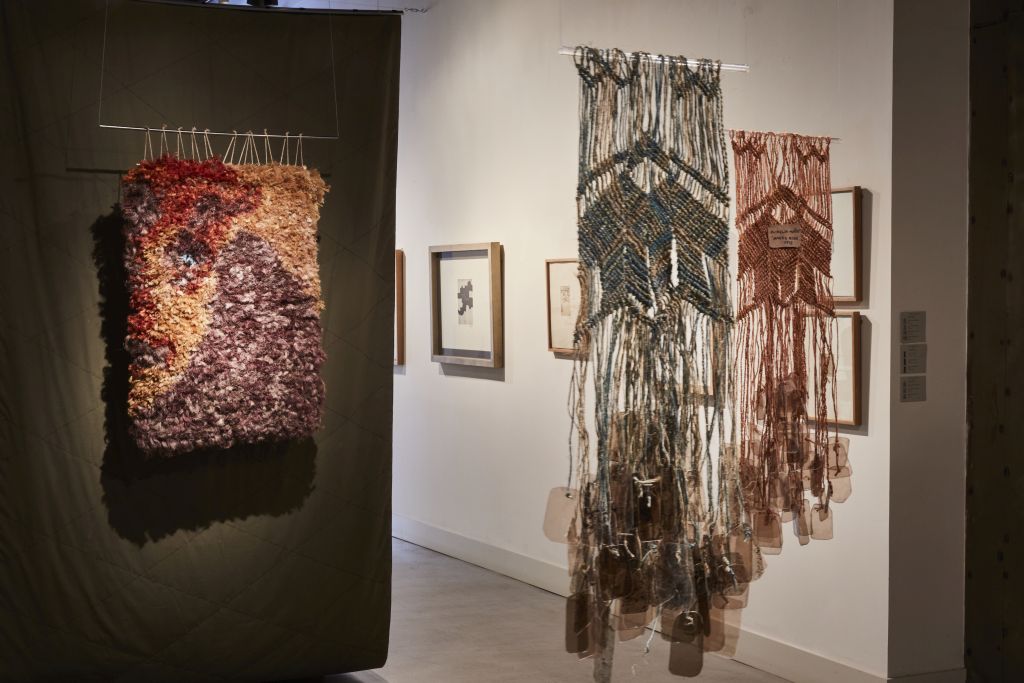Labyrinths and textures is Artur Ramon Art’s new commitment to textile art.
We present six female artists – Carla Mañosas, Aurèlia Muñoz, Francesca Piñol, Pilar Sala, Amparo de la Sota and Marga Ximénez – who work with textures and textile volumes with sinuous lines reminiscent of an imaginary labyrinth. Contemporary works in graphic analogy with a selection of engravings by Eduardo Chillida, African Kuba fabrics from the end of the 19th century, and a Turkish carpet from 1800 woven with the soumak technique.
“This proposal aims to make known artists and works that express themselves through the language of textiles in the world of museums and private collections, which are relevant for their expressive and conceptual strength.”
Sílvia Ventosa, exhibition curator
Carla Mañosas (Sant Cugat del Vallès, 1992) graduated in Art and Design at the Massana School in Barcelona, where she received the mention of Applied Arts. She has specialized in the art of weaving with different apprenticeships in Paris and Denmark. Nature is the source that inspires her work, based on the observation and interpretation of existing forms. Fabric is the material that acts as a connection between the artist and the intervened space, creating a game of relationships and values, a bond of union and respect for other biological rhythms different from ours. Although she is at the beginning of her career, she has already exhibited in several cities in Spain and Portugal.
Aurèlia Muñoz (Barcelona, 1926 – 2011) studied at the Montserrat secondary school, the School of Applied Arts and Artistic Crafts, and the Massana School in Barcelona. She approaches the art of weaving in the 1960’s when she began to paint burlap. In the seventies she undertook the task of asserting crafts and weaving as forms of cultural and artistic expression. The research process, an almost obsessive quest, has always been the basis of her work, characterized by a reinterpretation of handcraft/artisan techniques that elevates macramé, patchwork, tapestries and even Japanese origami to an avant-garde and abstract art form. She is a consecrated artist whose work can be found in the leading museums in the world, including the Kyoto Museum of Modern Art, The Art Institute of Chicago, The Cleveland Museum of Art, the Reina Sofía National Art Museum in Madrid, and the collection of the Emir of Dubai.
Francesca Piñol has a degree in Anthropology and Master’s degrees in Textile Design (UPC) and in African Studies (URV). Since 1999 she has been a professor of textile art and techniques at the Center for Art and Design of the Massana School in Barcelona. She associates art with neuroscience, and in 2018 she received an honourable mention in the international Art of Neuroscience competition. Her work stands out by the blend of colours, textures, shapes, and symbols, and by the fascination of the interweaving of diversities. Technically she works with low heddle looms, from the simplest to those with ties, of damask, and jacquard; this allows her to draw lines and shapes on the fabric itself, using the different textures that arise from the contrast between the ligatures and the coloured threads. She has exhibited in France, Italy, Egypt, Portugal, Denmark and other countries, in addition to Spain.
Amparo de la Sota (Madrid, 1963) is the daughter of artists, therefore she began her artistic training very early. She constructs her works with irregular pieces of old fabrics, sometimes torn and worn, recovered from the past and transformed into new realities. She uses threads and warps to develop complex abstract compositions, labyrinths blurred and balanced on the same level, giving rise to geometric rhythms and sequences, harmonized by a serene chromaticism. She has exhibited in Spain, Portugal, Ukraine, Mexico, and Uruguay.
Pilar Sala (Lorca, 1942) studied Pharmacy and through the seminars of critic Kevin Power and professor Francisco Jarauta she started in the art world. Her work consists in the production of contemporary tapestries, of high heddle weaving, and manual papermaking, working with cellulose fibres from plants. With a very personal view, she transforms her textures into installations, sculptures, collages, artist’s books and visual poems. She uses her art to make the society aware, especially regarding environmental issues and the search for freedom. In 1980 she obtained an honourable mention in the I National Tapestry Prize in Aranjuez, and she was Spanish representative in the VI International Tapestry Symposium in Graz (Austria). She has exhibited in Belgium, Germany, Taiwan, Russia, and Denmark, among other countries.
Marga Ximénez (Barcelona, 1950) is a plastic artist, sculptor, cultural manager, book illustrator, and teacher of textile techniques at the Faculty of Fine Arts in Barcelona. Her work, eminently sculptural, proposes a reflection on one’s own identity, introducing the concept of heteronym on the basis of a multiplicity of identities. An active feminist, her work also provides a deep reflection on the female condition in the face of life and death. She has exhibited in Spain, Switzerland, Poland and Denmark, among other countries. She was awarded the National Prize for Print Design in Spain, and she participated in the biennials of Lausanne, Poland, and Vicenza.










